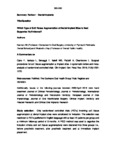Which type of soft tissue augmentation at dental implant sites is best supported by evidence?
| dc.contributor.author | Ali, Kamran | |
| dc.contributor.author | kay, elizabeth | |
| dc.date.accessioned | 2020-12-23T17:31:51Z | |
| dc.date.available | 2020-12-23T17:31:51Z | |
| dc.date.issued | 2020-12 | |
| dc.identifier.issn | 1462-0049 | |
| dc.identifier.issn | 1476-5446 | |
| dc.identifier.other | 0 | |
| dc.identifier.uri | http://hdl.handle.net/10026.1/16770 | |
| dc.description | 6 months embargo required. | |
| dc.description.abstract |
Data sources PubMed, the Cochrane Oral Health Group Trials Register and Embase. Additionally, issues of the following journals between 2000 and April 2019 were hand-searched: Journal of Clinical Periodontology, Journal of Periodontology, International Journal of Periodontology and Restorative Dentistry, European Journal of Oral Implantology, Journal of Oral and Maxillofacial Surgery, Clinical Implant Dentistry and Related Research, and Clinical Oral Implants Research.Study selection Only randomised controlled trials (RCTs) involving soft tissue augmentation at dental implant sites were considered for inclusion. The selection was restricted to RCTs published in English language with at least ten patients per group and a minimum follow-up period of three months. A PICO method was used to organise the inclusion criteria and soft tissue augmentations were clustered into three groups; that is, before prosthetic treatment, after prosthetic treatment and at immediate implant placement.Data extraction and synthesis The screening of titles and abstracts was carried out by two reviewers and disagreements were moderated by a third reviewer. Eligibility was determined using full texts and data were extracted using purposefully designed forms. The Cochrane handbook for systematic reviews of interventions toolkit was used to assess the risk of bias. The studies were grouped according to the type of intervention and subjected to quantitative data synthesis. Continuous outcome measures were assessed using random-effects meta-analyses and pooled estimates were expressed as weighted mean differences (MDs) along with 95% confidence intervals (CIs).Results Following initial electronic and hand-searches, 2,119 studies were screened for title and abstract, and 32 studies were considered for full-text screening. Only 14 RCTs met the inclusion criteria and the remaining 18 studies were excluded from the systematic review. The included studies described soft tissue augmentation for 538 implants placed in 475 patients. Three studies (68 patients; 78 implants) reported improved soft tissue thickness with xenogenic collagen matrix (XCM) augmentation compared to no augmentation at the implant sites before prosthetic treatment (high/unclear risk of bias). One study (28 patients; 41 implants) reported improved height of keratinised tissue (KT) and marginal bone levels (MBLs) with free gingival graft (FGG) compared to no augmentation at the implant sites after prosthetic treatment (unclear risk of bias). Three RCTs (126 patients; 126 implants) focused on connective tissue grafting (CTG) and bone grafting versus no grafting in conjunction with immediate implant placement after tooth extraction (unclear risk of bias). There was no difference in MBLs in any of the studies, while one study showed superior soft tissue thickness (STT). Four RCTs (129 patients; 133 implants) compared different augmentation techniques before prosthetic treatment. Only one study showed improved STT with CTG compared to XCM (low risk of bias). Finally, three RCTs (124 patients; 160 implants) compared different augmentation techniques after prosthetic treatment (high/unclear risk of bias). FGG was observed to be superior to acellular dermal matrix (ADM) and vestibuloplasty to improve KT. Meta-analyses did not favour CTG to improve MBLs at extraction sites but CTG was superior to XCM to improve STT before prosthetic treatment.Conclusions Notwithstanding the limitations of the systematic review, soft tissue augmentation significantly enhances the amount of soft tissue at the implant site. CTG at the extraction site also improves subsequent bone level of the implants. Moreover, CTG before prosthetic treatment is superior to XCM to improve thickness of peri-implant soft tissues. However, these findings are based on short-term follow-up and future studies with improved methodology are required to establish the long-term benefits of soft tissue augmentation at the dental implant sites. | |
| dc.format.extent | 140-141 | |
| dc.format.medium | ||
| dc.language | en | |
| dc.language.iso | en | |
| dc.publisher | Springer Science and Business Media LLC | |
| dc.subject | Connective Tissue | |
| dc.subject | Dental Implants | |
| dc.subject | Humans | |
| dc.subject | Randomized Controlled Trials as Topic | |
| dc.subject | Tooth Extraction | |
| dc.subject | Vestibuloplasty | |
| dc.title | Which type of soft tissue augmentation at dental implant sites is best supported by evidence? | |
| dc.type | journal-article | |
| dc.type | Journal Article | |
| dc.type | Comment | |
| plymouth.author-url | https://www.ncbi.nlm.nih.gov/pubmed/33339977 | |
| plymouth.issue | 4 | |
| plymouth.volume | 21 | |
| plymouth.publication-status | Published | |
| plymouth.journal | Evidence-Based Dentistry | |
| dc.identifier.doi | 10.1038/s41432-020-0138-y | |
| plymouth.organisational-group | /Plymouth | |
| plymouth.organisational-group | /Plymouth/Faculty of Health | |
| plymouth.organisational-group | /Plymouth/Research Groups | |
| plymouth.organisational-group | /Plymouth/Research Groups/Institute of Health and Community | |
| plymouth.organisational-group | /Plymouth/Research Groups/Institute of Translational and Stratified Medicine (ITSMED) | |
| plymouth.organisational-group | /Plymouth/Research Groups/Institute of Translational and Stratified Medicine (ITSMED)/CCT&PS | |
| plymouth.organisational-group | /Plymouth/Users by role | |
| dc.publisher.place | England | |
| dcterms.dateAccepted | 2020-01-26 | |
| dc.rights.embargodate | 2021-6-18 | |
| dc.identifier.eissn | 1476-5446 | |
| dc.rights.embargoperiod | Not known | |
| rioxxterms.versionofrecord | 10.1038/s41432-020-0138-y | |
| rioxxterms.licenseref.uri | http://www.rioxx.net/licenses/all-rights-reserved | |
| rioxxterms.licenseref.startdate | 2020-12 | |
| rioxxterms.type | Journal Article/Review |


